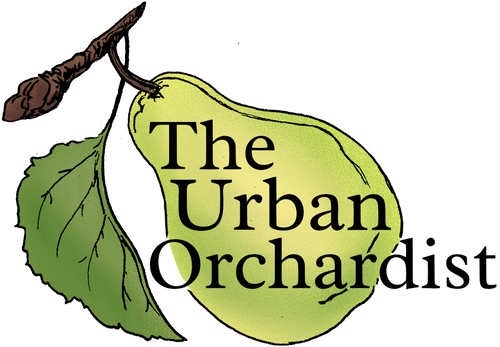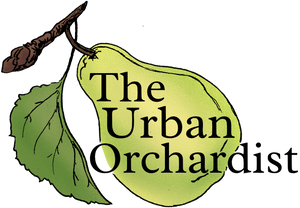I'm fascinated by quince - their large white-rose flowers, the lumpen fuzzy fruit, their use as a dessert fruit, and their long history. Quince fruits have been held in high regard for millennia throughout the Middle East and Europe, featuring in ancient Greek legends, and perhaps even being the fruit Eve ate in the Garden of Eden myth. Yet they barely make an appearance in North American grocery stores or food culture, despite them growing very well in our climate.
At The Urban Orchardist we grow and sell quince trees from seed, sourced from old parent trees that do well in cities of southwestern Ontario - Cambridge, Hamilton, Burlington, etc. Our seedlings grow beautifully, and are 4'-5' tall after their second year. We have a dozen for sale this spring, and you can purchase them here.
Note that these are not the same as the Japanese flowering quince shrubs that are a somewhat popular spiny ornamental shrub. These are Chaenomeles japonica, and I see them around Guelph every now and then - I even have one in my own yard. These produce a smaller, smooth fruit that smells similarly fragrant as the larger, fuzzy, lumpen fruit I'm referring to in this article, which are Cydonia oblonga.
Cydonia oblonga
The scientific name for the genus, Cydonia, comes from the old name for the city of Chania, on Crete, in Greece. Chania was once called Kydonia, and the earliest mention of the 'apple from Kydonia' was in a piece of 6th century Greek poetry. Quince fruits were held in great esteem in ancient Greece - used in rites of love, marriage, and fertility - and I have read that ancient Greeks were among the first to cultivate quince, and use wild seedlings as rootstocks to graft their preferred quince varieties onto.
Making quince edible
Unlike apples, quince fruits can't really be eaten fresh. They're very hard, and don't taste good. However, they smell beautiful, and as soon as you begin to cook them, this beautiful fragrance increases, and the fruit turns a rose-brown colour. I've cooked them down like applesauce, and I've made quince chutney, flavoured with cloves, cinnamon and the like, but my favourite way to use quince is in membrillo, which could be considered a candy, or a fruit cheese. The quince are cooked down into a paste, mixed with sugar, and set to gel and dry. The British marmalade was originally made with quince, not oranges; and the word is derived from the Portuguese name for quince, marmelo - quince jam being marmelada in Portuguese.

Pictured above are some preserves I purchased at a market in Syracuse, Sicily, in January 2023. This is a region that has been growing and making interesting food products out of quince for centuries. The two rose-coloured products are cotognata, a Sicilian version of membrillo. The item on the top left is made from dried prickly pear cactus fruit, and the item on the top right, well, I don't know what it is, but it tasted like black licorice. All were delicious and fun to try.
I could write tomes more about quince - the histories and legends that include them, their nutritious qualities, best practices in their cultivation, and so on. But this article is more of an introduction to the species.
While quince is certainly not a replacement for apples or pears (their most famous cousins in the pome family), I'm not sure a home orchard can be complete without a quince tree. They're beautiful, they're weird, they're delicious, and they have a storied past. I hope you can try them some day - maybe from your very own tree.
References:
Quince featured in History of Greek Food.
Quince featured in Stefan's Florilegium.
Title image: syaber, via Gardening Know How.

